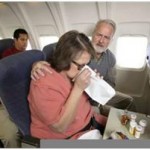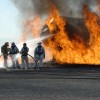In-flight medical problems and emergencies
In-flight medical problems and emergencies
Aim
- Practice English skills in an aviation context
- Become familiar with relevant medical terminology
- Have fun!
“Is there a doctor onboard?!” It’s a familiar scene from movies – Hollywood loves a medical emergency. So does the media. A woman giving birth on a plane, for example, is a great news story – and it happens.
Unfortunately, recently there have also been news stories of passengers suffering cardiac arrest and dying before being able to reach appropriate care. There is also a recent story about some unexpected turbulence on an American flight that caused injuries to 24 passengers and 4 crew members.
To quote one study, “In-flight medical events are a potentially significant problem. The airliner cabin at 35,000 feet is far from advanced medical care, space is restricted, the appropriate and necessary equipment for handling a given emergency may or may not be present, and qualified medical personnel are not generally available unless they are travelling on board as passengers. The cabin environment is also pressurised to an altitude in the range of 4,000 to 8,000 feet, which may pose its own difficulties for passengers with certain medical emergencies such as respiratory or cardiac arrest . Without treatment, a passenger suffering from a heart attack is unlikely to survive.”
(Source: http://www.skybrary.aero/bookshelf/books/955.pdf)
 Minor medical problems might include motion sickness, ear pain and gastro, while more serious medical problems include fainting, food poisoning and injuries. More examples are listed in the following article that suggests the growing number of older passengers combined with longer flights means an increase in the number in-flight health issues can be expected.
Minor medical problems might include motion sickness, ear pain and gastro, while more serious medical problems include fainting, food poisoning and injuries. More examples are listed in the following article that suggests the growing number of older passengers combined with longer flights means an increase in the number in-flight health issues can be expected.
It’s impossible for a flight attendant to be trained to deal with every kind of medical problem that might arise onboard, so it might also be wise to practice that line, “Is there a doctor onboard?”!
Link to article ‘In-flight health issues on rise’
Complete
1. An ageing population means passengers are boarding planes with ____________ health problems, researchers warn.
2. __________ __________ __________ could also increase the risk to health, they say.
3. In general, passengers should be able to ___________________________________ and __________________________________ if they are to be deemed fit to travel.
4. Several outbreaks of serious infections such as __________, __________, __________ and __________ have been reported on commercial flights.
Table 5: Types of medical event or injury (from An Analysis of In-flight Passenger Injuries and Medical Conditions , 1 January 1975 to 31 March 2006) (Source: http://www.skybrary.aero/bookshelf/books/955.pdf)
| Condition | Number | Percentage of total |
| Anxiety/panic attack | 2 | 0.70% |
| Bruising/lacerations | 14 | 4.93% |
| Burns | 4 | 1.41% |
| Drunk and/or violent | 14 | 4.93% |
| Ear injury | 1 | 0.35% |
| Eye injury | 3 | 1.06% |
| Fitting episode | 8 | 2.82% |
| Food poisoning | 3 | 1.06% |
| Fractures/dislocations | 9 | 3.17% |
| Fumes | 1 | 0.35% |
| Head injury | 29 | 10.21% |
| Heart attack | 43 | 15.14% |
| Loss of consciousness | 5 | 1.76% |
| Motion sickness | 4 | 1.41% |
| Musculoskeletal injury | 74 | 26.06% |
| Obstetric emergency | 1 | 0.35% |
Table 5: Continued
| Condition | Number | Percentage of total |
| Pain | 2 | 0.70% |
| Respiratory illness | 9 | 3.17% |
| Stroke | 2 | 0.70% |
| Suicide | 1 | 0.35% |
| Unspecified serious illness | 11 | 3.87% |
| Unspecified illness | 44 | 15.49% |
| Total | 284 | 100% |
- Which type of medical problem occurred most frequently during the time period for this survey?
- The survey told that all burns were due to hot drink spills. 50 % adult and 50% infant. How many in total?
- Which condition do you think would be most likely brought on by fear of flying?
- Which might require cabin crew restrain the passenger/passengers?
- 43 passengers experienced ______________.
Answers
- An ageing population means passengers are boarding planes with existing health problems, researchers warn.
- Extended flight times could also increase the risk to health, they say.
- In general, passengers should be able to walk a distance of 50m and climb one flight of stairs without angina or shortness of breath if they are to be deemed fit to travel.
- Several outbreaks of serious infections such as influenza, measles, severe acute respiratory syndrome (Sars) and tuberculosis have been reported on commercial flights.
- Musculoskeletal injury
- 4
- Anxiety/panic attack (Drunk/violent another possible answer here)
- Drunk/violent
- Heart attack
















Recent Comments